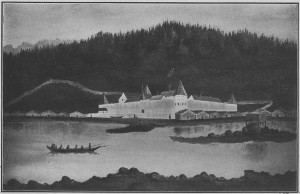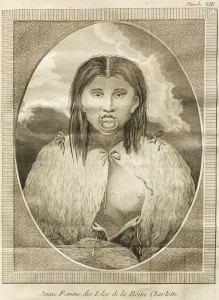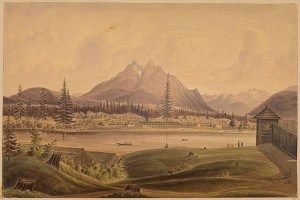13.5 Aboriginal Traders

Aboriginal trade leaders who would do much to set the tone and character of trade through the first half of the 19th century emerged across the region. The Legaic (or Ligeex) lineage in the Ts’msyan (Tsimshian) territories in the northwest, Kw’eh (or Kwah, ca. 1755-1840) of the Dakelh (Carrier) whose lands surrounded Fraser’s posts, and N’kwala (a.k.a. Hwistesmetxe’qen, ca. 1780-1865) in the Okanagan, Thompson, and Nicola Valleys dictated the location and circumstances under which fur trade posts could be established. In the case of the Legaics, they used marriage between daughters of the lineage to European traders (for example, between Sudaał and Dr. John Kennedy of the HBC in 1832) to secure long-term advantage and monopolies. This strategy of co-opting or adopting into a network of relations was coupled with tactics of bluster and power. Fort Simpson, near present-day Prince Rupert, provides another example. The HBC’s original plan was to build a fort on the Nass River, and while this might meet British trade objectives, it wasn’t satisfactory to the Ts’msyan who insisted that the first iteration be moved a substantial distance south to Lax Kw’alaams, a territory they preferred.[1]
Regional Powerhouses
Mostly these Aboriginal trade strategies reflected centuries-old commercial practices. The arrival of European goods, however, created a new kind of wealth that brought the possibility of cultural and political innovations. Regional political relationships were certainly in flux. Competition for primacy in the the new global commerce prompted the consolidation and sometimes the growth of alliances and areas of sovereignty. Mowachaht domination of northern Vancouver Island under the leadership of Maquinna extended east from Yuquot from the 1790s through the 1820s to incorporate the Kwakwaka’wakw peoples, the ‘Namgis (Nimpkish), mostly by means of commercial and diplomatic agreement. By contrast, Maquinna’s cousin Wikaninnish launched a violent campaign that created a tribute zone through the Broken Group Islands and across Clayoquot Sound. This bloody campaign, which is referred to as the Long War, predates direct contact and continued almost unobserved by Europeans through the 1840s. In the second decade of the 19th century the focus of the fur trade had moved along, but the Mowachaht and Tla-o-qui-aht (Clayoquot) systems continued to evolve, driven not by European directives but by their own agendas.
Similarly, regional power in the Interior was not static. In 1823 N’kwala, the hereditary leader of the Okanagan-Tk’emlups alliance, stormed across the southern valleys into Stl’atl’imc (Lillooet) territory at the head of what was reported to be a mounted cavalry of 500. The goals of the Okanagan were only partly informed by competition for fur trade primacy; the issues behind these conflicts had longer personal, diplomatic, and commercial histories. When the dust settled, N’kwala was confirmed by conquest and heredity as the head man of four nations with lands stretching from the Fraser River into the Rockies and from Soda Creek (Xats’ull) to Okanagan lands below the 49th parallel. All of these developments have in common the utilization of introduced assets: horses in the Interior, European vessels on the coast, and rifles at both places
By the 1820s the fur trade was shifting away from the coast. So long as the trade was conducted seasonally by visiting ships from Britain or the United States, the Aboriginal annual routine remained largely unchanged. The same was true at the few trading posts in the Interior when supplies arrived via the Columbia Express or Brigade Trails each spring. The threats and opportunities presented to the Aboriginal peoples by immediate neighbours remained more constant than the traders and, therefore, more important. Political influence and economic power could be exerted as before but now with greater force — and not entirely in the service of maximizing profit in the fur trade. Aboriginal agendas remained vital and somewhat aloof from Euro-North American concerns. At the same time, Aboriginal peoples found ways to turn the newcomers’ trade strategies against the foreigners.
Aboriginal traders recognized that fur fetched higher prices on the coast than in the Interior if there was competition by two or more trading ships in port. The price differential was sufficient to make it worthwhile for Interior traders to redirect their pelts down the grease trails to coastal markets. Coastal Aboriginal traders were thus positioned to gain more in this relationship, and they sought access to inland fur resources from the early 19th century. This had two effects. First, it rather obviously reduced the amount of furs available for trade to the NWC and HBC in the Interior. Second, it accelerated a process of what has been called “coastalization” among inland cultures. Coastal crests and clan systems were adopted as were potlatches and the labret.[2] Interior NWC and HBC traders, if they wanted to recover their position, would be obliged to offer more for furs.

Conditions for the fur trade were different in the Interior. There the societies were more egalitarian, and there was less likelihood of just one leader monopolizing the Aboriginal side of the trade. Euro-Canadian numbers were insignificant, so the newcomers had to either acquiesce to local practices or demonstrate absolute intolerance of transgressions.[3] There was certainly no hope of a gunboat sailing up the saltchuck, let alone a cavalry unit coming over the nearest hill to bail out troubled Euro-Canadians on the upper Columbia River, along the Thompson River, or north of the Cariboo Plateau. And while life in Interior Aboriginal communities might have been marked by egalitarianism, that was not the case in the HBC establishments. There, hierarchies prevailed and working conditions were demanding. Interior Aboriginal traders had to work within these constraints and were exposed to risks that were rare on the coast.
The HBC’s transition to a coastal, land-based trade began in the 1820s and expanded in the 1830s. As we have seen, this served HBC interests, but it also worked to the advantage of Aboriginal trade leaders. Instead of allowing the HBC to select sites based on its priorities and needs, Aboriginal influence was exerted so that the setting for trade maximized Aboriginal control over the Europeans. Aboriginal clans established homeguards around the forts, ensuring that any furs that arrived from other Native groups had to pass through local middlemen. In this way leaders like Legaic were able to filter trade in and out of locations like Fort Simpson to ensure their continued prosperity and authority.
Cultural Change
The focus of the HBC west of the Rockies was, perhaps not surprisingly, the fur trade. The number of personnel in the field was small, their familiarity with local conditions was patchy, and they were often placed in locations that were inhospitable. In places like Boat Encampment on Kinbasket Lake, on the York/Columbia Express route, the spring came late and the autumns were short: the Company’s business obviated the possibility of raising sheep or planting hayfields. Coastal fort sites, by contrast, were chosen on the basis of defensibility, harbour depth and shelter, and proximity to trading partners; gigantic Douglas Firs and rocky terrain were clear impediments to agriculture. In short, the intruders lacked the time, knowledge, and resources to raise their own food. This was a constant lament into the 1840s. For these reasons the regional traders depended heavily on food resources provided by Aboriginal peoples. Salmon (fresh and dried), roots, and berries were an essential part of the fur trade, albeit one that literally ate into the profits.[4]
Faced with supply-line issues similar to those that were breaking the Russian American Company (RAC), the HBC encouraged local agriculture. The Fort Simpson Ts’msyan and even the Haida across Hecate Strait began growing potatoes, which they traded with fort personnel. Similarly, around Fort Langley the local population began raising chickens and European vegetables in the late 1820s. In this way, as much as was possible, Aboriginal merchants/chieftains sought to establish, maintain, and — when needed — re-establish Euro-Canadian dependence.

As new farming practices emerged among Aboriginal peoples, so did new cultural practices. The shift to different tools of labour that had to be either manufactured or obtained and to new ways of working had a ripple effect on food preparation, diet, and the approach to land use and proprietorship. More immediately visible cultural changes were also occurring, particularly regarding the potlatch.
Potlatches grew to become spectacles by the second decade of the 19th century. This occurred for several reasons. European implements enhanced the output of traditional goods for redistribution. Iron tools enabled more rapid production of elaborate wood carvings like house-poles and finer metalwork, resulting in greater art production and creativity generally. Weaving of blankets — a currency in the traditional economy — increased, too. Styles modified to include new elements as coastal and interior artisans took advantage of what some scholars have identified as an efflorescence of regional artistic expression.
As well, exotic goods quickly worked their way into the heart of the potlatching culture. Maquinna’s 1803 potlatch, for example, “dispensed 400 yards of cloth, 100 looking-glasses, 100 muskets, and 20 kegs of gunpowder.”[5] Massive displays of material wealth (and exotic material wealth at that) enhanced the status of the host.
But the potlatch was changing due to local demographic conditions as well. The loss of population and particularly leaders through fur trade violence and disease created something of a scramble for position. Rivals tried to outdo one another, and village loyalties were divided by various claims to some chiefly status.[6] Potlatches became larger occasions with vast amounts of exotic goods being distributed to guests and delegations. These events became competitions: more material wealth, whether manufactured locally or abroad, led to more ostentatious potlatches and “fighting with property.”
The coastal fur trade impacted local cultures in other less obvious ways. For example, Maquinna’s brother Hannape and his four sons all learned both Spanish and English at the time of the Nootka Crisis. The speed with which they achieved facility in two foreign languages is remarkable. Elements of European languages were incorporated into the Chinook trade jargon but it is easy to overlook the widespread Aboriginal accomplishment of learning the newcomers’ tongues.
As well, new ideas about technologies and the wider world worked their way into communities. Wickaninnish of the Tla-o-qui-aht and Tatoosh of the Makah at Neah Bay conspired (unsuccessfully) to seize a European vessel. One study speculates that their intention was to establish direct trade between the peoples of the northwest coast and the Chinese markets. And why not? They had heard a great deal about China from the Europeans and Americans and were sharp enough traders to realize where they stood in the larger economic relationship. What’s more, the rogue trader John Meares introduced the Nuu-chah-nulth to about 130 Chinese labourers in 1788. Contact between the Nuu-chah-nulth and China was, in this sense, an established fact.
Contact with the outsiders and the diplomatic attentions of the British and Spanish in particular had the additional effect of challenging leadership norms in the region. Maquinna emerged as a powerful and popular leader because he headed a confederacy of partners who may, from time to time, have challenged his primacy but who generally approved of his consensus-based approach. Wickaninish, on the other hand, was an oligarch whose regime was much more centralized and, thus, more vulnerable.[7] The Europeans’ dealings with Wickaninish were generally less predictable and less mutually satisfying, which worked to the advantage of Maquinna’s federation. Strategies of governance were in this way questioned and destabilized.
Probably the key factor influencing the pace of change was the impact of exotic diseases, especially smallpox and measles. Epidemics caused by exotic viruses may have occurred as early as the 1780s.[8] There is no evidence to suggest these were all-encompassing, so some communities and sub-regions were weakened more than others. Venereal diseases may or may not have been indigenous to the Pacific Northwest but the presence of fur traders and sailors certainly didn’t help matters. It is thought that the establishment of Fort Langley (and, by extension, any fort) resulted in a local epidemic of sexually transmitted infections.[9]
Loss of life to disease created instabilities in leadership and military preparedness. It could reduce the fertility of a population and therefore oblige some consolidations of communities. Epidemic mortalities may also explain the apparent rise in slave-raiding from Lekwitok territory in the upper Strait of Georgia into the Juan de Fuca Strait and the Fraser Valley. On southern Vancouver Island in 1839 it was reckoned that slaves nearly outnumbered nobles and commoners among the Lekwungen, an indication perhaps that slaves were filling in gaps left by disease. At the very least it shows that slavery was not the exception to the rule.[10] In each of these cases, cultural change or adaptation was necessary. These were, however, changes that were guided by Aboriginal principles and priorities, not by missionaries or colonial officials. Circumstances in this regard would begin to change in the 1840s.
Key Points
- Aboriginal communities and leaders used a variety of strategies to exert control over the fur trade and over the foreign traders.
- Power structures in Native communities were continually evolving, though now with assets derived through trade with the newcomers.
- Aboriginal peoples largely controlled the cultural changes that arose because of contact.
- The potlatch, which was at the centre of economic, political, and social life on the coast, intensified and changed as a result of contact and trade.
Attributions
Figure 13.15
Fort Simpson, B.C. in 1857. – NARA by US National Archives bot is in the public domain.
Figure 13.16
Voyage autour du monde by Spinster is in the public domain.
Figure 13.17
H. B. Co. Fort Langley, left bank of Fraser River by US National Archives bot is in the public domain.
- Clarence Bolt, Thomas Crosby and the Tsimshian: Small Shoes for Feet Too Large (Vancouver: UBC Press, 1992): 15. ↵
- James R. Gibson, Otter Skins, Boston Ships, and China Goods: The Maritime Fur trade of the Northwest Coast, 1785-1841 (Montreal & Kingston: McGill-Queen’s University Press, 1992), 270. ↵
- Duane Thomson and Marianne Ignace, "'They Made Themselves Our Guests': Power Relationships in the Interior Plateau Region of the Cordillera in the Fur Trade Era," BC Studies 146 (Summer 2005): 3-35. ↵
- William J. Turkel, The Archive of Place: Unearthing the Pasts of the Chilcotin Plateau (Vancouver: UBC Press, 2007), 150-1. ↵
- Gibson, Otter Skins, 270. ↵
- Ibid., 270-1. ↵
- Yvonne Marshall, “Dangerous Liaisons: Maquinna, Quadra, and Vancouver in Nootka Sound, 1790-5,” in From Maps to Metaphors: The Pacific World of George Vancouver, eds. Robin Fisher and Hugh Johnston (Vancouver: UBC Press, 1993), 165-9. ↵
- Robert Boyd, The Coming of the Spirit of Pestilence: Introduced Infectious Diseases and Population Decline among Northwest Coast Indians, 1774-1874 (Vancouver: UBC Press, 1999). ↵
- Cole Harris, The Resettlement of British Columbia: Essays on Colonialism and Geographical Change (Vancouver: UBC Press, 1997), 77. ↵
- John Lutz, Makuk: A New History of Aboriginal-White Relations (Vancouver: UBC Press, 2008), 61. ↵

